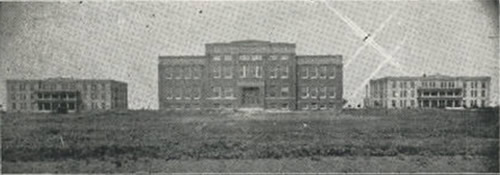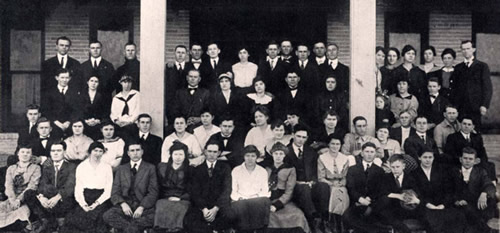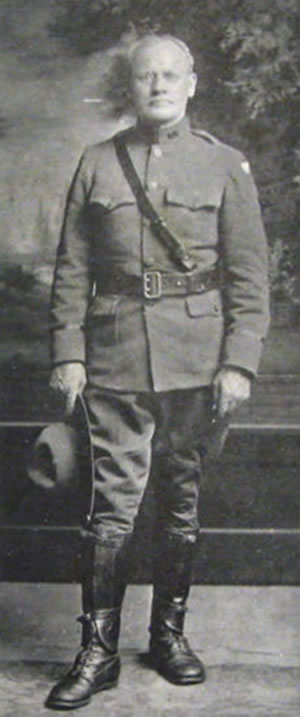|
|
In
regards to the COVID-19 Pandemic, which has already threatened to
permanently close the doors of smaller schools nationwide, I found
it suitable to examine the life of Wesley College, once a prosperous
junior college in Greenville
that, like other academic institutions in the 1930s, came to a tragic
end.
North Texas University School, the predecessor of Wesley College,
was established on the family property of Robert A. Terrell in Terrell,
a rural community southeast of Dallas,
in June 1905. The institution, originally a high school, opened
with 125 male and female students (that number significantly increased
to 230 a couple of months later). Its president was Reverend Joseph
A. Morgan, previously the pastor of Garland's Methodist Church.
Students enrolled in preparatory classes in classical languages,
history, mathematics, English, and music. The school was a success
from the start, primarily due to the overwhelming support from Terrell's
citizens-who had donated 13 acres of land-and the North Texas Conference
of the Methodist Episcopal Church, South-the governing board over
Methodist colleges in the region which gave large amounts of money
to establish Morgan's school. In 1909, the school changed its name
to Wesley College (in honor of John Wesley, the founder of Methodism)
and relabeled itself as a "high-grade literary school," aimed at
preparing pupils for admittance to Texas's best Methodist schools,
including Southwestern University in Georgetown.
|
 |
Wesley
College Physical Plant, 1918
The McLean Administration Building, center,
is flanked by two dormitories (named Wesley and Delaney Halls)
Click on image to enlarge
|
|
After
their local elections in 1910, the City of Greenville launched a
fund-raising campaign in an attempt to lure Wesley College to their
community. The townsfolk offered the Methodist Church $125,000 and
20 acres of land south of the city. On September 17, 1912, Wesley
College opened its doors in Greenville,
and attracted an average enrollment of 400 students per year over
the next two decades. The campus physical plant consisted of the
McLean Administration Building and two dormitories. During the presidencies
of David H. Aston, Reverend Seth E. Green, and George F. Winfield,
faculty with strong Christian values were hired and the college
received national junior college standing. Student life flourished-students
would either ride the public bus into downtown Greenville or join
the on-campus Astonian and B.J. Williams Literary Societies and
partake in cordial debates. Moreover, the college had student-led
home county clubs (including Collin, Dallas, Hopkins, and Hunt Counties).
The YMCA and YWCA were highly active in the 1920s and it was common
to see students engage in yoga on the lawns. The college's philosophy
of developing the whole man-physically, mentally, socially, morally,
and spiritually-was wholeheartedly supported by the City of Greenville.
This admiration is evident by the city's $38,000 donation to the
college after the administration building burned down in November
1922.
|
 |
B.J. Williams
Literary Society, 1916
This academic society was named in honor of Mrs. B.J. Williams,
a major benefactor of the college in the 1910s.
Click on image to enlarge |
|
Wesley College
attracted a large number of talented faculty. Coach John W. Rollins,
a Texas A&M college graduate, was hired as the school's P.E. instructor
in the 1920s. Coach Rollins (or named by students as 'Dough' since
the instructor often bragged about his money) trained hundreds of
award-winning athletes and steered the basketball and football teams
to a string of victories (the students chose the panther as their
mascot). Also, Coach Rollins introduced athletic scholarships at
the college in 1924 and traveled thousands of miles across Texas
recruiting the top high school athletes. Coach Rollins would later
lead the East Texas State Teachers College Lions to several Lone
Star Conference titles in the 1930s. Another faculty member who
left a lasting impressing on her students was Mrs. Ruth B. Jackson,
instructor of English and wife of the seventh president. One of
her classes, English I, was regarded by many as the hardest course
at Wesley College since the assignments included reading a dozen
books and writing 300 pages of journal entries. Neita Flennikan
recalled her time as a student in Mrs. Jackson's English class:
"She was very demanding, just gave you good, strong, long assignments-some
of them were so long you thought you'd never get them done…she really
had strong courses."
Under the guidance of a first-class faculty, students at Wesley
College excelled in their studies and careers. Fladger Tannery is
one of Wesley College's best known alumni; he attended the school
in the 1920s and graduated as president of the B.J. Williams Literary
Society. He continued his education at Southern Methodist University
in Dallas and then joined the University of Texas at Austin faculty
in 1933 as an assistant professor of accounting. Following a stint
in the U.S. Air Force, Tannery was president of the H.W. Lay & Co.
from 1962 to 1965. Tatsuzi Tacheuchi (who named himself 'Sterling')
was Wesley's first international student from Japan in 1921. After
participating in the ministry program and graduating in 1923, Tacheuchi
took his teachings overseas and served in the Japanese Diplomatic
Corps during the 1930s. His post-studies successes inspired a small
group of international students from Cuba, Mexico, and Venezuela
to enroll in the college in the late 1920s.
Despite the challenging coursework, strict instructors, and regimented
schedules, students at Wesley College credited the school for giving
them a well-rounded academic foundation. G.C. Randolph, a 1926 graduate
and an active minister in North Texas for over 45 years, credited
the college for guiding him towards God's word: "It prepared me
for a beginning in life that I wouldn't have had otherwise." Another
student, who had enjoyed observing plants at Greenville's park during
class outings, said, "My years at Wesley gave me some idea about
what life was all about-the real values in life." Edith M. Taylor,
daughter of the college's business manager, harped on the fact that
she and the student body, "All feel that Wesley College was one
of the great influences in our lives because we had such wonderful
teachers, such wonderful faculty, good Christian atmosphere, and
good disciplinarians." When Dr. George Bernard Jackson assumed the
presidency in 1925, he made great strides to continue the work of
his predecessors in making Wesley College a home for critical thinkers
by strengthening Christian values in classrooms, reinforcing the
importance of global citizenship in excursions, and increasing enrollment
to over 520 students. Wesley College was prospering by the end of
the 1920s.
|
 |
Dr. George Bernard
Jackson, 1918
Dean (and then President) Jackson would later be on the faculties
at Austin College and Lon Morris College. |
|
The Stock
Market Crash of 1929 and the Great Depression that followed caused
many schools in the South to dig deeper into their coffers, panic,
and abruptly close, including old-time rival Burleson College in
December 1930. Several Wesley trustees contended the idea of merging
the remnants of Burleson's
student body and faculty with the operations at Wesley College.
They argued that collaboration between the schools would financially
work for both parties, despite religious differences, citing the
initial success between two higher-education institutions in Sherman
as an example: Kidd-Key College, a Methodist school for women, and
Austin College, its Presbyterian sister (ironically, Kidd-Key College
would close its doors in 1935 due to financial problems and low
enrollment numbers, while Austin College endured). In contrast,
Wesley College alumni strongly opposed the suggested merger, claiming
that religious schism between the institutions was "too great for
a consolidation." Shortly after, hardships also hit Wesley College.
The college was financially struggled by the fall semester of 1931,
and the budget was cut significantly. Faculty were unpaid for several
months between 1931 and 1932, provoking low morale among the teachers;
a couple of disgruntled fine arts teachers left Wesley and established
their own schools in Dallas.
After Mr. 'Skipper' Wright's bus broke down, briefly ending student
transportation to downtown, President Jackson decided to eliminate
the football program and allocate those funds to repair the bus.
Moreover, the student body morale declined when many pupils were
unable to provide for their unemployed parents and find employment
in the region (only a small group of students were offered a job
in the dining hall canning produce from the Rio Grande Valley).
To make matters worse, President Jackson struggled to receive money
from the North Texas Conference and had to constantly reinforce
the legitimacy of Wesley's junior college status since Charles Claude
Selecman, president of SMU, strongly believed that his four-year
institution be the sole recipient of the conference's annual monetary
allocations. Amidst the stress, Dr. Jackson angered several Board
members, was dismissed from the college in May 1934, and became
"crazy as a loon," regretting his decisions in not saving the college.
During the brief presidential tenure of John E. Blackburn (1934-1937),
enrollment dropped to its lowest point in more than two decades
(200 students, most hailed from Greenville), and students were required
to purchase their own class materials since faculty were given no
money to. When Joseph Garland Roach, an alumnus and former principal
of Greenville Senior High School, arrived to take the reins in fall
1937, the mood on campus was somber. Wesley College was barely afloat.
According to that semester's records, the number of student clubs
had decreased, and the college's Greyhound yearbook and Pilot
newsletter were both discontinued. In 1937, the ministry program
was depleted of resources and interest, 58% of the student body
in 1937 were non-Methodists, and the college owed $39,000 to the
church and other local businesses. Wesley College received little
funds from the Conference that year. Also, much to the surprise
of the administrators, local long-time benefactors discontinued
their support-Mrs. Mason, college registrar, recalled that, "Greenville
slipped by not helping Wesley College and keeping it here. It really
is a shame…It needed more support."
There were some efforts by Dr. Roach's team to make Wesley a state
school, yet those failed. Aware that time was disappearing, and
despite the frequent criticism they had received from the SMU president,
Jess Morris, the Wesley Board's president, addressed a letter to
Dr. Selecman in February 1938, "concerning Southern Methodist University's
becoming the repository of the credits of Wesley College after it
ceases to operate as such…"-indeed, several small Wesley artifacts
were placed in the SMU library after 1938. The final commencement
occurred without fanfare in May 1938; students and faculty knew
the college would not hold classes in the fall. In July, President
Roach, exhausted from the financial burdens that had plagued his
sole year in office, met with his faculty for the last time, distributed
the remaining money among them, and quietly departed from the school.
Wesley College, once a titan of education in Northeast Texas, closed
its doors in pitiful ruin.
Why did Wesley College close when it proved to be initially successful?
The financial hardships from the Great Depression and gradual disinterest
from local benefactors and sponsors played key roles in the college's
demise. Furthermore, the North Texas Conference of the Methodist
Episcopal Church, South made a grave mistake by focusing a majority
of their time and money in the development of large, four-year institutions
instead of smaller junior colleges. By the start of the 1930s, the
Conference threw their weight behind Southern Methodist University
while the little schools in North Texas like Wesley College were
little more than afterthoughts. Albert Deems Betts, president of
Paine College in Augusta, Georgia, noted that Southern Methodists
have "buried one hundred and five institutions of learning in her
educational century…Had the church long ago founded a General Board
of Education with proper financial power, we would be far better
off today and many costly mistakes would have been saved." Unfortunately,
Wesley College fell as a victim of ignorance.
|
Bibliography
Harrison, W. Walworth. History of Greenville and Hunt County, Texas
(Waco: Texian, 1976).
McMullin, William C. "A Descriptive History of Wesley College."
Ed.D. diss., University of North Texas, 1987.
Stolz, Jack. Terrell (San Antonio: Naylor Publishing Co., 1973).
Various records from the college, Greyhound yearbooks (several
are also found at the Bridwell Library on the SMU campus), Pilot
newsletters, and photographs from the Northeast Texas History
and Genealogy Center at W. Walworth Harrison Library, 1895-1930,
James G. Gee Library, Texas A&M University-Commerce. |
Author Biography:
Joshua V. Chanin is adjunct instructor of history and community director
of Whitley Hall at Texas A&M University-Commerce. He received his
M.A. in history from the University of Texas at Arlington, and specializes
in the history of women and education in Texas. |
|
|
